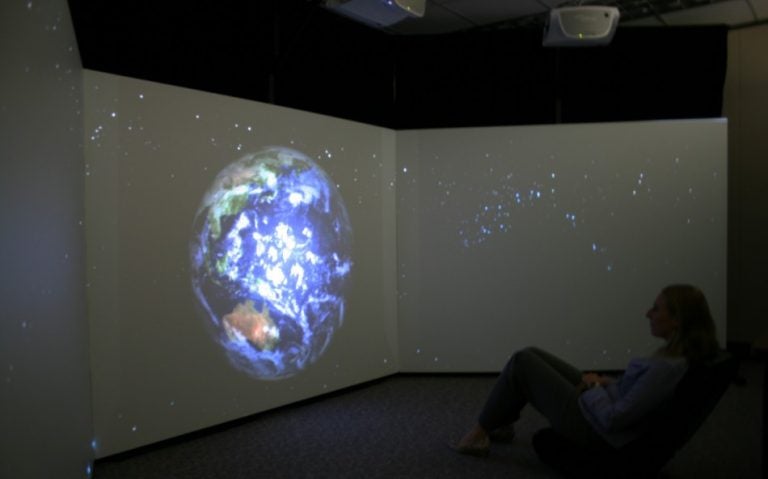When was the last time you were in awe of something? Or maybe experienced wonder?
Maybe it was standing on the edge of the Grand Canyon, or witnessing birth, or walking along the beach at sunrise.
A team of University of Central Florida researchers thinks those feelings of awe and wonder can be scientifically studied, and recently finished a two-year project to better understand the experiences of those emotions and their relationship to religious and spiritual beliefs.
As part of the project, the researchers held an Orlando conference attended by about 60 neuroscientists, philosophers, psychologists, and art historians from around the world to discuss their findings and how to apply them to future uses, from providing medical treatments to swaying movie audiences.
The research, supported by a $300,000 grant from the John Templeton Foundation, got its genesis from the frequent comments of returning astronauts who talk about how they were changed by the emotional experience of spaceflight, often spiritually, said Lauren Reinerman, assistant research professor in the UCF Institute for Simulation and Training.
“We wanted to know if we could assess the physiological and psychological responses of awe and wonder and better understand that experience,” she said.
For the purposes of the study, the researchers defined awe as “a direct and initial feeling when faced with something incomprehensible or sublime.” Wonder was defined as “a more reflective feeling one has when unable to put things back into a familiar conceptual framework.”
Researchers used an interdisciplinary approach to create a simulation of space travel for the purpose of gathering neurophysiological and phenomenological data. Phenomenology is the study of the development of human consciousness and self-awareness.
“Even though astronauts come from a variety of backgrounds, including military, engineering and science, the awesomeness of viewing earth from a shuttle or gazing into the vastness of the universe from the ISS [International Space Station] elicits states of AW [awe and wonder],” according to the study, “Going one step further, many astronauts report a paradigm of feeling that there must be something bigger out there, something holding everything together. Many astronauts have written about these deeply aesthetic, spiritual and religious experiences.”
For the study, researchers individually tested 79 people in rooms designed to mimic space vehicles. On a 120-degree screen, test subjects visibly experienced a countdown, liftoff and spaceflight around the earth and through deep space.
The “flights” of the subjects lasted 12 minutes.
Beforehand they were questioned about their backgrounds, traits and religious beliefs. During the tests, monitors recorded brain and heart functions that correlated to the visual and emotional timeline. And afterward, the subjects were questioned about stress, their reflections and thoughts of themselves.
Results showed that the test subjects said they experienced varying degrees of awe and wonder.
Reinerman said the people who identified themselves as more religious actually were less prone to report awe and wonder. Perhaps they just thought “This is God’s work,” and already expected it to be awesome, she said.
Reinerman said the team’s findings are relevant for better understanding and predicting what astronauts might experience during long-term space flight, and that commercial space flight might benefit by informing training simulators how to prepare people for experiencing space.
The researchers said they imagine that one day their findings can be applied to other fields.
“It is expected that our results will inform future research for investigating the development of improved or alternative treatments for people with PTSD, autism, anxiety disorders, maybe even diabetes, or even just everyday stress,” Reinerman said. “The sense of peace and the introspection that was reported to occur while participants viewed our simulated space visuals might be beneficial for incorporation into therapeutic practices. The simulation is a way, in a sense, to help people ‘meditate’ or reflect; it puts life to the idea of visualization that is often practiced in treatment.”
She said that capturing the visual stimuli that influence the experience of awe, wonder, curiosity, humility, and other emotions also could help the entertainment industry construct environments that invoke those experiences.
Bruce Janz, a philosopy professor involved with the project and the chair of the department, said the study’s approach was a different way of doing philosophy that focuses on the human experiences we have, and how they relate to who we are.
“Thinking about experiences like awe and wonder…rarely do we get a chance to think about what those experiences mean for us as humans in such an unusual place as space,” Janz said. “To be able to rethink how we ask about awe and wonder from the point of view of life in space adds an important perspective to how we think about philosophy.”
Others involved in the study were Shaun Gallagher, a former UCF philosophy professor who helped start the project and now is at the University of Memphis, and Brandon Sollins, a research assistant at UCF’s Institute for Simulation and Training.
The research team is working to secure additional funding to expand the project.
“Some findings surprised us,” said Patricia Bockelman, a graduate research assistant. “We’d like to think everyone experiences awe and wonder sometimes but empirically nobody is looking at this across the board.”
